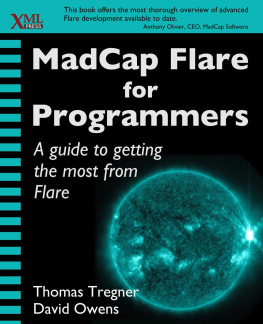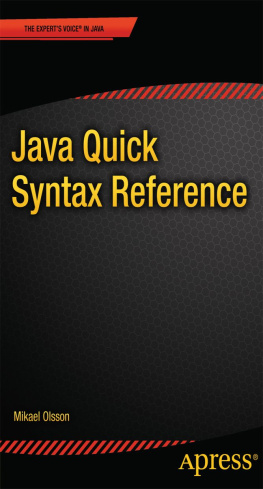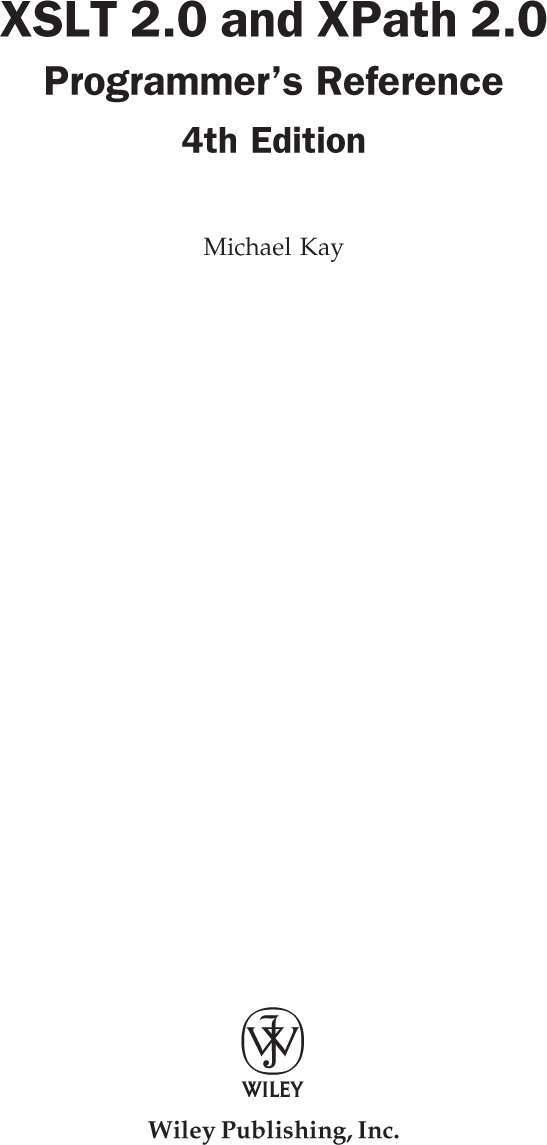XSLT 2.0 and XPath 2.0 Programmer's Reference 4th Edition
Published by
Wiley Publishing, Inc.
10475 Crosspoint Boulevard
Indianapolis, IN 46256
www.wiley.com
Copyright 2008 by Wiley Publishing, Inc., Indianapolis, Indiana
Published simultaneously in Canada
ISBN: 978-0-470-19274-0
Library of Congress Cataloging-in-Publication Data is available from the publisher.
No part of this publication may be reproduced, stored in a retrieval system or transmitted in any form or by any means, electronic, mechanical, photocopying, recording, scanning or otherwise, except as permitted under Sections 107 or 108 of the 1976 United States Copyright Act, without either the prior written permission of the Publisher, or authorization through payment of the appropriate per-copy fee to the Copyright Clearance Center, 222 Rosewood Drive, Danvers, MA 01923, (978) 750-8400, fax (978) 646-8600. Requests to the Publisher for permission should be addressed to the Legal Department, Wiley Publishing, Inc., 10475 Crosspoint Blvd., Indianapolis, IN 46256, (317) 572-3447, fax (317) 572-4355, or online at http://www.wiley.com/go/permissions.
Limit of Liability/Disclaimer of Warranty: The publisher and the author make no representations or warranties with respect to the accuracy or completeness of the contents of this work and specifically disclaim all warranties, including without limitation warranties of fitness for a particular purpose. No warranty may be created or extended by sales or promotional materials. The advice and strategies contained herein may not be suitable for every situation. This work is sold with the understanding that the publisher is not engaged in rendering legal, accounting, or other professional services. If professional assistance is required, the services of a competent professional person should be sought. Neither the publisher nor the author shall be liable for damages arising herefrom. The fact that an organization or Website is referred to in this work as a citation and/or a potential source of further information does not mean that the author or the publisher endorses the information the organization or Website may provide or recommendations it may make. Further, readers should be aware that Internet Websites listed in this work may have changed or disappeared between when this work was written and when it is read.
For general information on our other products and services please contact our Customer Care Department within the United States at (800) 762-2974, outside the United States at (317) 572-3993 or fax (317) 572-4002.
Trademarks : Wiley, the Wiley logo, Wrox, the Wrox logo, Wrox Programmer to Programmer, and related trade dress are trademarks or registered trademarks of John Wiley & Sons, Inc. and/or its affiliates, in the United States and other countries, and may not be used without written permission. All other trademarks are the property of their respective owners. Wiley Publishing, Inc., is not associated with any product or vendor mentioned in this book.
Wiley also publishes its books in a variety of electronic formats. Some content that appears in print may not be available in electronic books.
To Anyone Who Uses This Book
To Make the World a Better Place
About the Author
Michael Kay has been working in the XML field since 1997; he became a member of the XSL Working Group soon after the publication of XSLT 1.0, and took over as editor of the XSLT 2.0 specification in early 2001. He is also a member of the XQuery and XML Schema Working Groups, and is a joint editor of the XPath 2.0 specification. He is well known not only through previous editions of this book but also as the developer of the open source Saxon product, a pioneering implementation of XSLT 2.0, XPath 2.0, and XQuery 1.0.
In 2004 the author formed his own company, Saxonica, to provide commercial software and services building on the success of the Saxon technology. Previously, he spent three years with Software AG, working with the developers of the Tamino XML server, an early XQuery implementation. His background is in database technology: after leaving the University of Cambridge with a Ph.D., he worked for many years with the (then) computer manufacturer ICL, developing network, relational, and object-oriented database software products as well as a text search engine, and held the position of ICL Fellow.
Michael lives in Reading, England, with his wife and daughter. His hobbies (reflected in his choice of examples) include genealogy and choral singing, and once included chess. Since completing the previous edition he has found time to improve his croquet handicap to 6.
Credits
Director of Acquisitions
Jim Minatel
Development Editor
Maureen Spears
Technical Editor
Sam Judson
Production Editor
Angela Smith
Copy Editor
Foxxe Editorial Services
Editorial Manager
Mary Beth Wakefield
Production Manager
Tim Tate
Vice President and Executive Group Publisher
Richard Swadley
Vice President and Executive Publisher
Joseph B. Wikert
Project Coordinator, Cover
Lynsey Stanford
Proofreader
Nancy Carrasco
Indexer
Robert Swanson
Acknowledgments
There are two groups of people I must thank: those who contributed to the book, and those who supported me in writing it.
In the first group, I am indebted to readers of previous editions who have pointed out my errors, and have told me what they liked and didn't like. I hope readers of this edition will do the same. Also to the (by now numerous) reviewers and editors engaged first by the original Wrox team in the UK, and more recently by their successors in Wiley, who have done so much of the legwork of testing example code and finding continuity errors, not to mention handling the unseen production processes that turn a heap of word-processed text into a finished book. Then my colleagues on the working groups, who provided the subject matter for me to write about, and those who taught me how to use the languageif you find a programming pearl that you particularly like in this book, the chances are I stole the idea from someone. James Clark in particular, who invented the XSLT language and showed me how it worked.
In the second group, I must once again acknowledge the patience of my family, who sighed resignedly when I suggested the prospect of retreating to my study for half a year to produce a new revision, and the generosity of my past employers who provided the time to get the project off the ground in the first place.
Introduction
This book, as the title implies, is primarily a practical reference book for professional XSLT developers. It assumes no previous knowledge of the language, and many developers have used it as their first introduction to XSLT; however, it is not structured as a tutorial, and there are other books on XSLT that provide a gentler approach for beginners.
Who This Book Is For
The book does assume a basic knowledge of XML, HTML, and the architecture of the Web, and it is written for experienced programmers. There's no assumption that you know any particular language such as Java or Visual Basic, just that you recognize the concepts that all programming languages have in common.
I have tried to make the book suitable both for XSLT 1.0 users upgrading to XSLT 2.0, and for newcomers to XSLT. This is easier to do in a reference book, of course, than a tutorial. I have also tried to make the book equally suitable whether you work in the Java or .NET world.

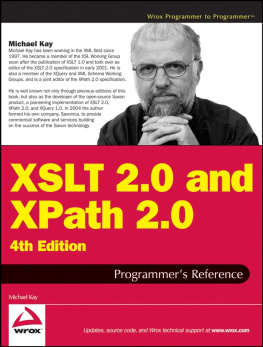


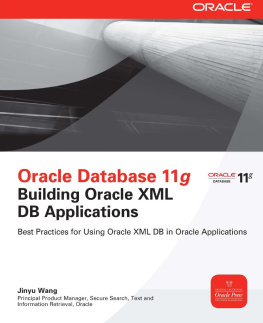
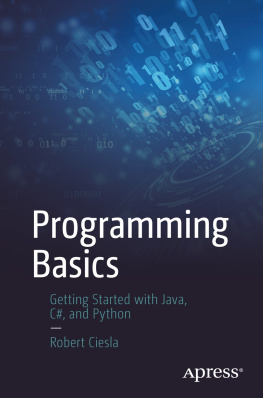

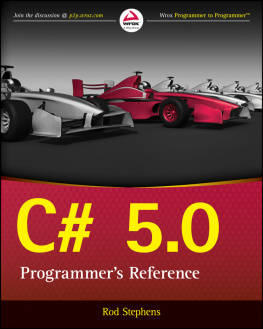
![Jeff Friesen [Jeff Friesen] - Java XML and JSON: Document Processing for Java SE](/uploads/posts/book/124064/thumbs/jeff-friesen-jeff-friesen-java-xml-and-json.jpg)
